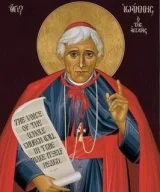My Dear People,
In Rome on Christmas Day, 1852, Pope Pius IX received into the Catholic Church Dr. Levi Silliman Ives, the second Episcopal Bishop of North Carolina. It is a fascinating, little-known story about a courageous soul involved in the Oxford Movement that re-introduced Catholic teaching to Anglican life.
 Blessed John Henry Newman was the progenitor of the movement, which was perhaps to have its greatest impact on these shores. Ives’ theological formation came as this Catholic movement began to influence a new generation of Anglican clergy and laity. In 1822 he married the daughter of Bishop Hobart of New York; the father must have been pleased, since he ordained him the next year. In 1831, at the age of 33, he was elected Bishop of North Carolina.
Blessed John Henry Newman was the progenitor of the movement, which was perhaps to have its greatest impact on these shores. Ives’ theological formation came as this Catholic movement began to influence a new generation of Anglican clergy and laity. In 1822 he married the daughter of Bishop Hobart of New York; the father must have been pleased, since he ordained him the next year. In 1831, at the age of 33, he was elected Bishop of North Carolina.
His episcopal career was a difficult one. The diocese did not welcome his high church ways. A diocesan commission took up charges that he was teaching confession, transubstantiation, reservation of the Blessed Sacrament, devotion to the Blessed Virgin Mary, and the need for Anglicanism to be reunited to the Catholic Church. Bishop Ives was forced to backtrack and assure the diocese that he was unreservedly Anglican.
But it didn’t work. One’s conscience cannot survive such convolutions, as the Catechism of the Catholic Church teaches: “A human being must always obey the certain judgment of his conscience” (¶1790). In 1852, the bishop asked the standing committee for a sabbatical, for health reasons, and journeyed to Rome. Perhaps we in the Ordinariate have some sense of his struggles and the relief that came when the decision was finally made. Three days before the Pope received him, he wrote to his diocese to resign his office so that he might obey his conscience, informed by “clear and settled convictions,” and make his submission to the Catholic Church. He would later write a moving account of his journey, Trials of a Mind in its Progress to Catholicism: A Letter to His Old Friends (1854).
The response from his old friends was not so gracious. To leave the Episcopal Church back then was regarded as an act of apostasy. Such converts (turning around) were then called perverts (turning in a bad way). He was said to be suffering from a form of mental illness: “the bishop had been in a state of mental illness that impaired his judgment.” Thankfully today we are in a (mostly) different place!
Dr. Ives returned to America to teach at an institution that would later become part of Fordham University. He and his wife had found the peace and joy that full communion brings. These courageous pioneering souls laid the foundations for the ecumenical progress that would one day come in Anglican-Roman Catholic relationships. They were the “first fruits” of the work of Christian unity, the legacy that now falls on us to continue.
“This is a strange Christmas letter”, you may be saying. But his Christmas reception would not be coincidental. Dr. Ives would find his life’s work in the founding of the Catholic Protectory in the Bronx, the largest Catholic orphanage of its day. Just as St. Joseph, he would find his vocation in the nurture and care of God’s little children. In 1867, Dr. Ives died with these words on his lips: “Oh, how good God has been to me!” He was buried at the Protectory, today St. Raymond’s Cemetery, a wonderful witness to the social and doctrinal integrity of Catholic life.
The Son of God came to share not only his Father’s mind but also his heart. Dr. Ives’ journey to full communion began as deep theological engagement, but his act of conscience would become a life of service. And this is how he would be remembered, his work inspiring the foundation of many such orphanages throughout the Catholic Church in America.
Pope Francis spoke in this way of St. Joseph on his feast day this year: “How does Joseph respond to his calling to be the protector of Mary, Jesus and the Church? By being constantly attentive to God, open to the signs of God’s presence and receptive to God’s plans, and not simply to his own.”
May God bless you with a joyous and holy Christmas!
Msgr. Jeffrey Steenson
P.S. Full credit to Prof. William Tighe of Muhlenberg College, who introduced me to Ives’ inspiring story at the time of my conversion.











What a wonderful inspiring story. It is certainly an Ordinariate story. The reference to the Catechism of the Catholic Church (p1790) is most telling—–“A human being must ALWAYS obey the certain judgement of his conscience” . Fr. Bill H.
It is inspiring. I can certainly see why Prof Tighe brought the story to Msgr Steenson’s attention when he did, and this would make a moving talk at an OCSP clerical retreat. Its relevance to the average OCSP layperson, who was probably expecting the usual year-end overview of where we have been and where we are going, is less clear. The emphasis on the Catholic Protectory as Ives’ “life work”—something he took on less than two years before his death—seems forced, and of course these institutions, which were essentially reform schools, were very much of their time and do not necessarily resonate in the 21st C. An unusual choice for a Christmas letter, all in all.
PS Picture also pretty wild.